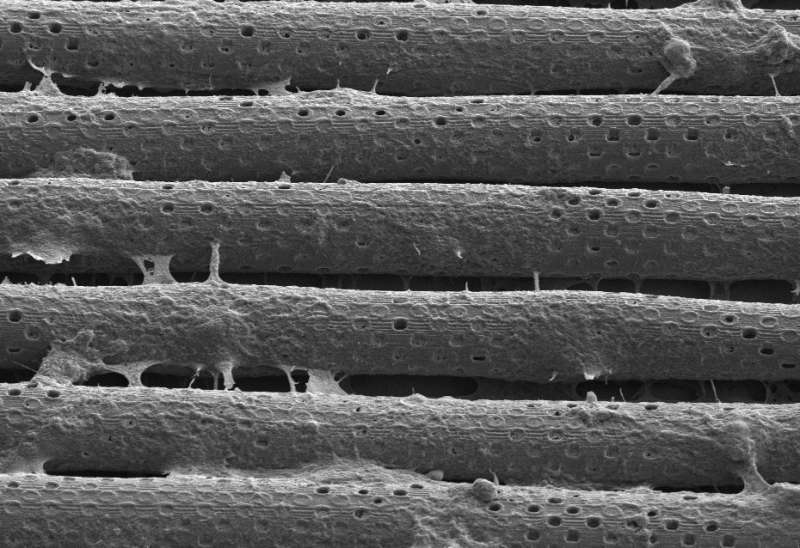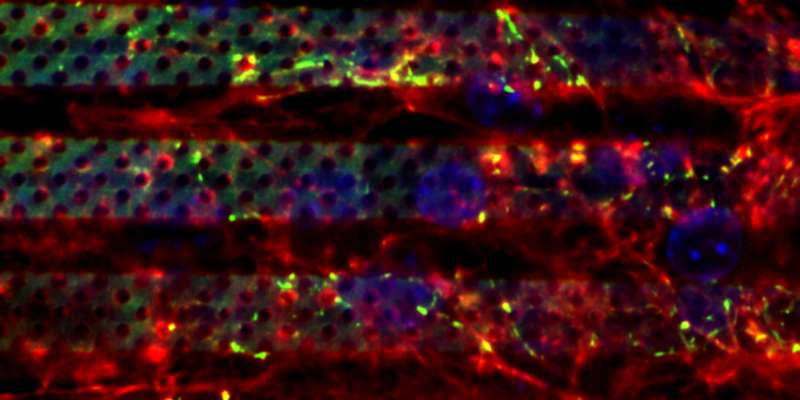Scanning electron microscopy image of endothelial cells cultured on the tubular scaffold. The cells built a biological barrier resulting in a biohybrid system which resembles its natural model. Credit: IIT-Istituto Italiano di Tecnologia
Researchers at IIT-Istituto Italiano di Tecnologia fabricated an artificial device reproducing a 1:1 scale model of the blood-brain barrier (BBB), the anatomical and functional structure that protects the central nervous system from external toxins, but which also screens drugs when they are injected intravenously. The device, which is a combination of artificial and biological components, is fundamental for studying new therapeutic strategies to overcome blood-brain barrier and treat brain conditions such as tumors.
The study was coordinated by Gianni Ciofani, researcher at IIT in Pontedera (Pisa) and Professor at Politecnico di Torino. The device is described in a paper published today in Small. It is a microfluidic device that combines artificial components made with 3-D advanced microfabrication techniques (two-photon lithography) and endothelial cells.
The microprinting was realized with advanced 3-D printing technologies that make use of a laser that scans through a liquid photopolymer and solidifies the material locally and layer-by-layer, building complex 3-D objects with submicron resolution. Using this manufacturing technique, researchers were able to engineer an accurate, full-scale model of the BBB made from a photopolymer resin. Mimicking the brain microcapillaries, the model consists of a microfluidic system of 50 parallel cylindrical channels connected by junctions and featuring pores on the cylinder walls. Each of the tubular structures has a diameter of 10 μm and pores of 1 μm diameter uniformly distributed on all cylinders. After the fabrication of the complex, scaffold-like polymer structure, endothelial cells were cultivated around the porous microcapillary system. Covering the 3-D printed structure, the cells built a biological barrier resulting in a biohybrid system resembling its natural model. The device is few millimeters in size and fluids can pass through it at the same pressure as blood in brain vessels.
Confocal image of 3-D bio-hybrid microfluidic blood-brain barrier model: endothelial cells have been stained in blue for nuclei, in red for f-actin, in green for tight junctions. Credit: IIT-Istituto Italiano di Tecnologia
The prototype has been developed through an extremely multidisciplinary approach based on micro- nanofabrication competencies, modeling and microfluidic dynamics.
In the future, researchers will use the device to understand the interaction of drugs or of drug delivery nano-vectors to overcome the blood-brain barrier and target the central nervous system. The main goal is to find new therapeutic strategies for the treatment of brain cancer and brain diseases, such as Alzheimer and multiple sclerosis.
More information: Attilio Marino et al, A 3D Real-Scale, Biomimetic, and Biohybrid Model of the Blood-Brain Barrier Fabricated through Two-Photon Lithography, Small (2017). DOI: 10.1002/smll.201702959
Journal information: Small
Provided by Istituto Italiano di Tecnologia - IIT
























